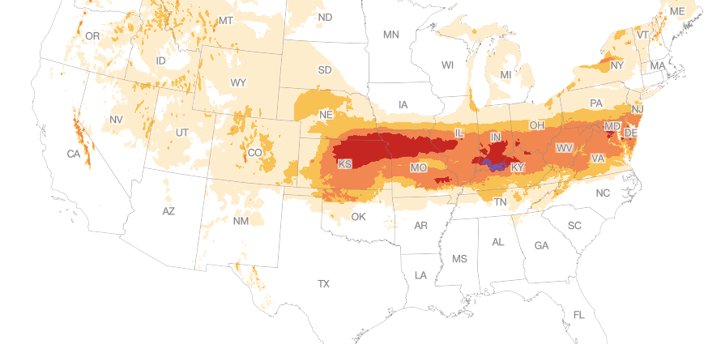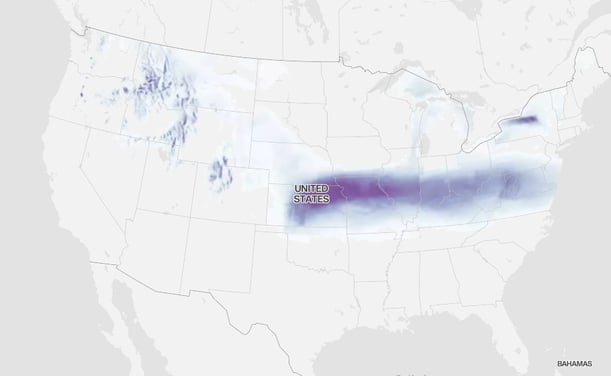Massive Winter Storm Grips Central U.S., Affecting Millions with Snow, Ice, and Heavy Rain
VIRALNEWS


Massive Winter Storm Grips Central U.S., Affecting Millions with Snow, Ice, and Heavy Rain
A powerful winter storm is sweeping across the central United States, putting nearly 70 million people under winter weather alerts. The storm is expected to deliver a mix of snow, ice, and blizzard conditions, with wind gusts reaching up to 50 mph.
The system, which has already created hazardous conditions in the Central Plains, is forecasted to cause travel disruptions, power outages, and dangerous conditions from Missouri to the Mid-Atlantic.
Significant Snowfall Expected
The National Weather Service’s Weather Prediction Center has warned that some areas could experience their heaviest snowfall in over a decade. The Winter Storm Severity Index highlights the potential for major disruptions, including “dangerous or impossible driving conditions and widespread closures” through Sunday in parts of the Central U.S.
Regional Forecasts:
Kansas City, MO: Blizzard warning until 4 a.m. ET Monday. Snowfall of 6–14 inches, with ice and 45 mph wind gusts.
St. Louis, MO: Winter storm warning through Monday morning. Mixed precipitation transitioning to snow, with 4–12 inches of accumulation and up to 0.4 inches of ice.
Indianapolis, IN: Heavy snow and ice, with totals of 6–9 inches and a light glaze of ice through Monday evening.
Louisville, KY: Snow accumulations of 6–10 inches, with ice up to 0.75 inches possible through Monday.
Cincinnati, OH: Snow and ice totals of 5–10 inches through late Monday.
Washington, D.C.: Snow mixed with sleet, with accumulations of 5–9 inches. Some suburban areas could see up to 12 inches.
Philadelphia, PA: Snow accumulations of 2–4 inches expected Monday.
Dangerous Ice Conditions
An ice storm warning remains in effect for parts of southern Illinois, western Kentucky, and southeast Missouri, with significant icing likely in the central Appalachians and parts of Maryland and Delaware. Travel in these regions is highly discouraged, as roads and bridges are expected to become treacherous.
The National Weather Service warns of ice accumulations between 0.25 and 0.75 inches in some areas, posing a high risk of power outages and hazardous travel conditions.
Emergency Declarations
Governors in Kentucky, Virginia, Arkansas, and Missouri have declared states of emergency. Maryland’s governor has also issued a state of preparedness, urging residents to avoid non-essential travel.
"This storm will bring dangerous conditions on the roads and likely significant power outages, just as extreme cold arrives," Kentucky Governor Andy Beshear stated.
Flight Cancellations and Travel Warnings
The storm has already caused widespread flight cancellations. Nearly 75% of flights out of Kansas City International Airport and over half of those from St. Louis Lambert International Airport were canceled Sunday morning.
Travel remains strongly discouraged in areas under blizzard or ice storm warnings. Kansas Highway Patrol Trooper Ben Gardner pleaded with residents to stay home, emphasizing the dangers posed by the storm.
Record Snowfall Possible
Major cities, including Kansas City and Indianapolis, could see historic January snowfall totals. Kansas City is on track to surpass its record of 7.2 inches set in 2011, while Indianapolis could exceed its 2014 record of 11.4 inches.
Southern States Brace for Thunderstorms
In the South, parts of Louisiana, Arkansas, and Mississippi are under a level 3 severe thunderstorm threat, with damaging winds, hail, and potential tornadoes expected.
Bitter Cold to Follow
As the storm exits the East Coast late Monday, temperatures across the eastern two-thirds of the U.S. are expected to plummet, with some areas experiencing drops of 30 degrees below normal. This will solidify snow and ice accumulations, prolonging hazardous conditions.
Residents in affected areas are advised to stay informed, avoid unnecessary travel, and prepare for potential power outages and extreme cold.


